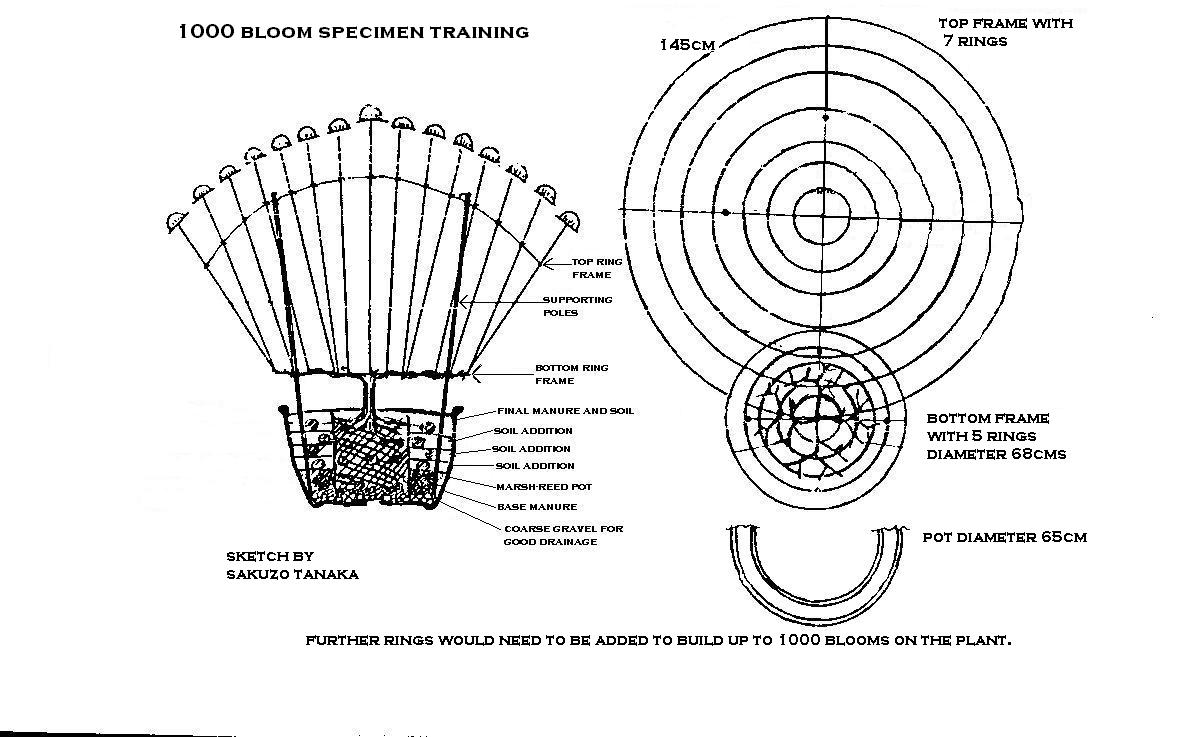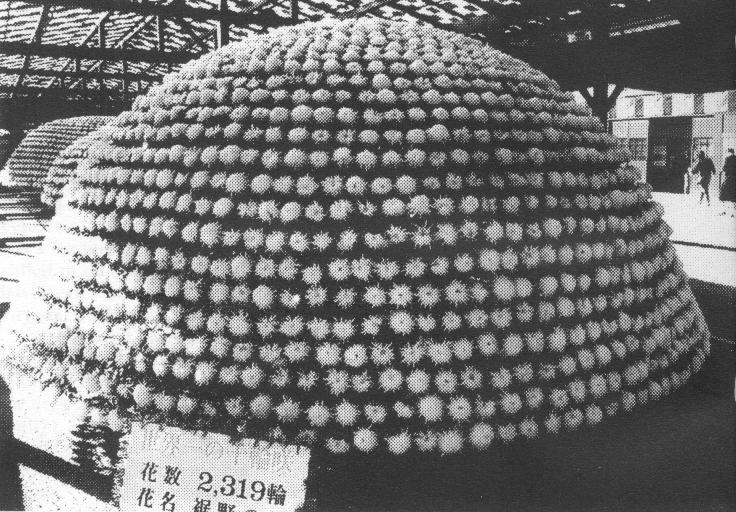Chrysanthemums
were cultured for the first time in Japan around the middle of the Nara
period (710-784 a.d.). They came to be grown and enjoyed by common people
500 years later during the Edo period. Around 1750 flourishing exhibitions
and shows were held on a grand scale at many places. This kind of show
was extremely prosperous at that time. 'Kazudate' and 'Ohzukuri' (making
a multitude of flowers) were trained already. Traditional methods of
culturing chrysanthemums have been inherited for more than 250 years.
As for
1000 bloom specimen, there are two types as follows:
1. Culture in pot - culture as a hobby.
Starting with plantation in a small pot, the plant is transferred to
a bigger pot in accordance with the growth and supported by poles. This
requires many processes and troubles but the result is beautiful.
2. Culture in the ground and then into a pot - culture for commercial
basis.
Plant the roots in bamboo baskets first, and put them in the ground.
When the buds become tinted in autumn, the plants are transferred to
bigger pots. The flowers are arranged in order by branch selection.
The plants area adjusted at the flower head by the mass production method.
How to make culture
soil as compost
Since the longevity of chrysanthemums is one to two years, the roots
of large flowers may be vigorous for only around ten months. In order
to have large flowers and branch elongation within this short period,
the best compost will be required.
The following
quality will be necessary for good compost:
1. The ability to preserve manure. Main soil should be obtained from
piled soil at marsh, river and valley.
2. Good drainage. Fallen leaves, moderately corroded, should be available.
3. The ability to keep water. Rough sand and a clod should be available.
4. Sunshine aeration. Unburnt cinders of charcoal and grass ash should
be available.
The above cannot be obtained so rapidly. It is advisable to collect
the necessary materials gradually, although it takes time. When you
get them in hand, mix them to ferment and mound them in a heap. Mix
them two or three times so that the soil will be sufficiently fermented.
Upon completion, it should be disinfected by exposure to the sunlight,
and it should be kept dry. Before using it, give it water one week ahead
of use in order to make the soil ready.
Selection of kind
Some sorts of chrysanthemums may not be available for the 1000 bloom
specimen. It is advisable to select the kind which will be effective
for making the 1000 bloom style.
The following
are the essential conditions:
1. The roots should be strong enough to absorb much manure, and they
should easily branch.
2. The plant should be strong in elongation.
3. The shape of leaves should be large and in good form, and no elongation
between leaves.
4. The flowers should be huge with numerous petals.
5. 'Atsubashiri' variety is more suitable, then 'Atsumono" (decorative),
and finally 'Kudamono’ (incurve).
6. The colour of the flowers should be clear and lasting.
Recent varieties
which are suitable for 1,000 bloom specimen
Atsumono variety
Taiheizan (white), Souan-hakusen (white), Kokkano-kotobuki (gold), Kokka-daimangetsu
(yellow), Senkyo-chikuzen (yellow), Hoko-kissho (pink), Taiho-chitose
(pink), Taiho-togetsu (red), Kenroku-kogiku (red), Toyamano-aki (yellow),
Shinkogen-no Kumo (yellow), Kokka-kenbu (white).
Kudamono variety
Kokka-ryubi (big, red), Hagoromo-hamakaze (big, pink), Kokka-ujo (medium,
red), Shimizu-chigusa (medium, yellow), Tailio-shiraniam (big, white).
(Australian growers who have tried this process have that Connie Mayhew
and Kokka Kenraku are suitable.)
Monthly process
of works
November
Preparation for planting. The vigorous winner rhizomes in a pot should
be transplanted to a pot of No. 5 to No. 6 size. The pot should be managed
in a frame house. Prevent the plant from needless elongation.
January
The 1st pinching at the plant height of 15 to 18 cm. Transfer to a pot
of No. 7 to No. 8 size, leaving 4 to 5 shoots.
February-March
The 2nd pinching. Ensure even growth of lateral shoots and arrange distribution
of branches. Leave 12 to 15 shoots.
April
Prepare a quasi-pot, with marsh-reed and transfer the plant to the final
pot of no. 18 with diameter of 65cm. Leave 40 to 45 shoots by 3rd pinching.
May
Soil and manure to be added. In the middle of the month, set up the
bottom ring frame. Leave 100 to 110 shoots by the 4th pinching.
June
Soil and manure to be added. Fix the main branch to the bottom ring
frame. Leave around 160 shoots by the 5th pinching. For each branch,
leave two spare shoots and pull off the weak shoots.
July
Soil and manure to be added. Set up the top ring frame and put up the
supporting poles.
August
The final manure be added. Disinfect by spraying the aqueous solution
of chemicals. Adjust the height of the plant.
September
Selection of buds. Soil to be added.
October
Flower manure to be given. Adjust the height of the plant and attach
a ring base to all flowers. Thus on 20th of this month, the 1000 bloom
specimen is ready for exhibition.
Please refer to the sketch below.AAAAAAAAAAA


A MAGNIFICENT 1000 BLOOM CHRYSANTHEMUM
